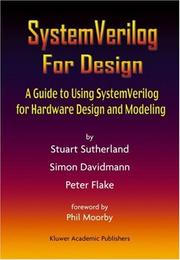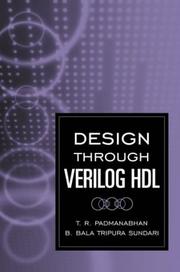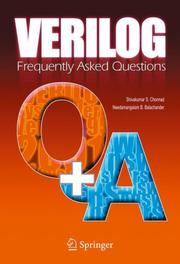| Listing 1 - 5 of 5 |
Sort by
|
Book
ISBN: 0738145246 Year: 2004 Publisher: New York, New York : IEEE,
Abstract | Keywords | Export | Availability | Bookmark
 Loading...
Loading...Choose an application
- Reference Manager
- EndNote
- RefWorks (Direct export to RefWorks)
The Verilog(R) Hardware Description Language (HDL) is defined in this standard. Verilog HDL is a formal notation intended for use in all phases of the creation of electronic systems. Because it is both machine readable and human readable, it supports the development, verification, synthesis, and testing of hardware designs; the communication of hardware design data; and the maintenance, modification, and procurement of hardware. The primary audiences for this standard are the implementors of tools supporting the language and advanced users of the language.

ISBN: 1402075308 Year: 2004 Publisher: New York (N.Y.) Springer
Abstract | Keywords | Export | Availability | Bookmark
 Loading...
Loading...Choose an application
- Reference Manager
- EndNote
- RefWorks (Direct export to RefWorks)

ISBN: 1280557079 9786610557073 0471722995 0471723002 9780471723004 0471441481 9780471441489 Year: 2004 Publisher: Piscataway, New Jersey [Piscataqay, New Jersey] IEEE Press IEEE Xplore
Abstract | Keywords | Export | Availability | Bookmark
 Loading...
Loading...Choose an application
- Reference Manager
- EndNote
- RefWorks (Direct export to RefWorks)
A comprehensive resource on Verilog HDL for beginners and experts Large and complicated digital circuits can be incorporated into hardware by using Verilog, a hardware description language (HDL). A designer aspiring to master this versatile language must first become familiar with its constructs, practice their use in real applications, and apply them in combinations in order to be successful. Design Through Verilog HDL affords novices the opportunity to perform all of these tasks, while also offering seasoned professionals a comprehensive resource on this dynamic tool. Describing a design using Verilog is only half the story: writing test-benches, testing a design for all its desired functions, and how identifying and removing the faults remain significant challenges. Design Through Verilog HDL addresses each of these issues concisely and effectively. The authors discuss constructs through illustrative examples that are tested with popular simulation packages, ensuring the subject matter remains practically relevant. Other important topics covered include: . Primitives. Gate and Net delays. Buffers. CMOS switches. State machine design Further, the authors focus on illuminating the differences between gate level, data flow, and behavioral styles of Verilog, a critical distinction for designers. The book's final chapters deal with advanced topics such as timescales, parameters and related constructs, queues, and switch level design. Each chapter concludes with exercises that both ensure readers have mastered the present material and stimulate readers to explore avenues of their own choosing. Written and assembled in a paced, logical manner, Design Through Verilog HDL provides professionals, graduate students, and advanced undergraduates with a one-of-a-kind resource.
Book
ISBN: 140208028X Year: 2004 Publisher: Boston : Kluwer Academic Publishers,
Abstract | Keywords | Export | Availability | Bookmark
 Loading...
Loading...Choose an application
- Reference Manager
- EndNote
- RefWorks (Direct export to RefWorks)
Chapter 3 Specifying RTL Properties 61 3. 1 Definitions and concepts 62 62 3. 1. 1 Property 3. 1. 2 Events 65 3. 2 Property classification 65 Safety versus liveness 66 3. 2. 1 3. 2. 2 Constraint versus assertion 67 3. 2. 3 Declarative versus procedural 67 3. 3 RTL assertion specification techniques 68 RTL invariant assertions 69 3. 3. 1 3. 3. 2 Declaring properties with PSL 72 RTL cycle related assertions 73 3. 3. 3 3. 3. 4 PSL and default clock declaration 74 3. 3. 5 Specifying sequences 75 3. 3. 6 Specifying eventualities 80 3. 3. 7 PSL built-in functions 82 3. 4Pragma-based assertions 82 3. 5 SystemVerilog assertions 84 3. 5. 1 Immediate assertions 84 3. 5. 2Concurrent assertions 86 3. 5. 3 System functions 95 3. 6 PCI property specification example 96 3. 6. 1 PCI overview 96 3. 7 Summary 102 Chapter 4 PLI-Based Assertions 103 4. 1 Procedural assertions 104 4. 1. 1 A simple PLI assertion 105 4. 1. 2 Assertions within a simulation time slot 108 4. 1. 3 Assertions across simulation time slots 111 4. 1. 4 False firing across multiple time slots 116 4. 2 PLI-based assertion library 118 4. 2. 1 Assert quiescent state 119 4. 3 Summary 123 Chapter 5 Functional Coverage 125 5. 1 Verification approaches 126 5. 2 Understanding coverage 127 5. 2. 1 Controllability versus observability 128 5. 2.
Integrated circuits --- Verilog (Computer hardware description language) --- Very large scale integration --- Design and construction. --- Verification. --- Hardware verification --- Integrated circuit verification --- Verification of hardware --- Verification of integrated circuits --- Verilog hardware description language (Computer hardware description language) --- Engineering. --- Computer-aided engineering. --- Electrical engineering. --- Electronic circuits. --- Circuits and Systems. --- Electrical Engineering. --- Computer-Aided Engineering (CAD, CAE) and Design. --- Computer hardware description languages --- Computer simulation --- Systems engineering. --- Computer engineering. --- Computer aided design. --- CAD (Computer-aided design) --- Computer-assisted design --- Computer-aided engineering --- Design --- Computers --- Engineering systems --- System engineering --- Engineering --- Industrial engineering --- System analysis --- Design and construction --- Electric engineering --- CAE --- Electron-tube circuits --- Electric circuits --- Electron tubes --- Electronics --- Data processing

ISBN: 0387228993 0387228349 Year: 2004 Publisher: New York, New York : Springer,
Abstract | Keywords | Export | Availability | Bookmark
 Loading...
Loading...Choose an application
- Reference Manager
- EndNote
- RefWorks (Direct export to RefWorks)
The Verilog Hardware Description Language was first introduced in 1984. Over the 20 year history of Verilog, every Verilog engineer has developed his own personal “bag of tricks” for coding with Verilog. These tricks enable modeling or verifying designs more easily and more accurately. Developing this bag of tricks is often based on years of trial and error. Through experience, engineers learn that one specific coding style works best in some circumstances, while in another situation, a different coding style is best. As with any high-level language, Verilog often provides engineers several ways to accomplish a specific task. Wouldn’t it be wonderful if an engineer first learning Verilog could start with another engineer’s bag of tricks, without having to go through years of trial and error to decide which style is best for which circumstance? That is where this book becomes an invaluable resource. The book presents dozens of Verilog tricks of the trade on how to best use the Verilog HDL for modeling designs at various level of abstraction, and for writing test benches to verify designs. The book not only shows the correct ways of using Verilog for different situations, it also presents alternate styles, and discusses the pros and cons of these styles.
Verilog (Computer hardware description language) --- Application-specific integrated circuits --- Design. --- Systems engineering. --- Computer science. --- Engineering design. --- Circuits and Systems. --- Programming Languages, Compilers, Interpreters. --- Engineering Design. --- Electronic circuits. --- Programming languages (Electronic computers). --- Design, Engineering --- Engineering --- Industrial design --- Strains and stresses --- Computer languages --- Computer program languages --- Computer programming languages --- Machine language --- Electronic data processing --- Languages, Artificial --- Electron-tube circuits --- Electric circuits --- Electron tubes --- Electronics --- Design --- Design and construction.
| Listing 1 - 5 of 5 |
Sort by
|

 Search
Search Feedback
Feedback About UniCat
About UniCat  Help
Help News
News